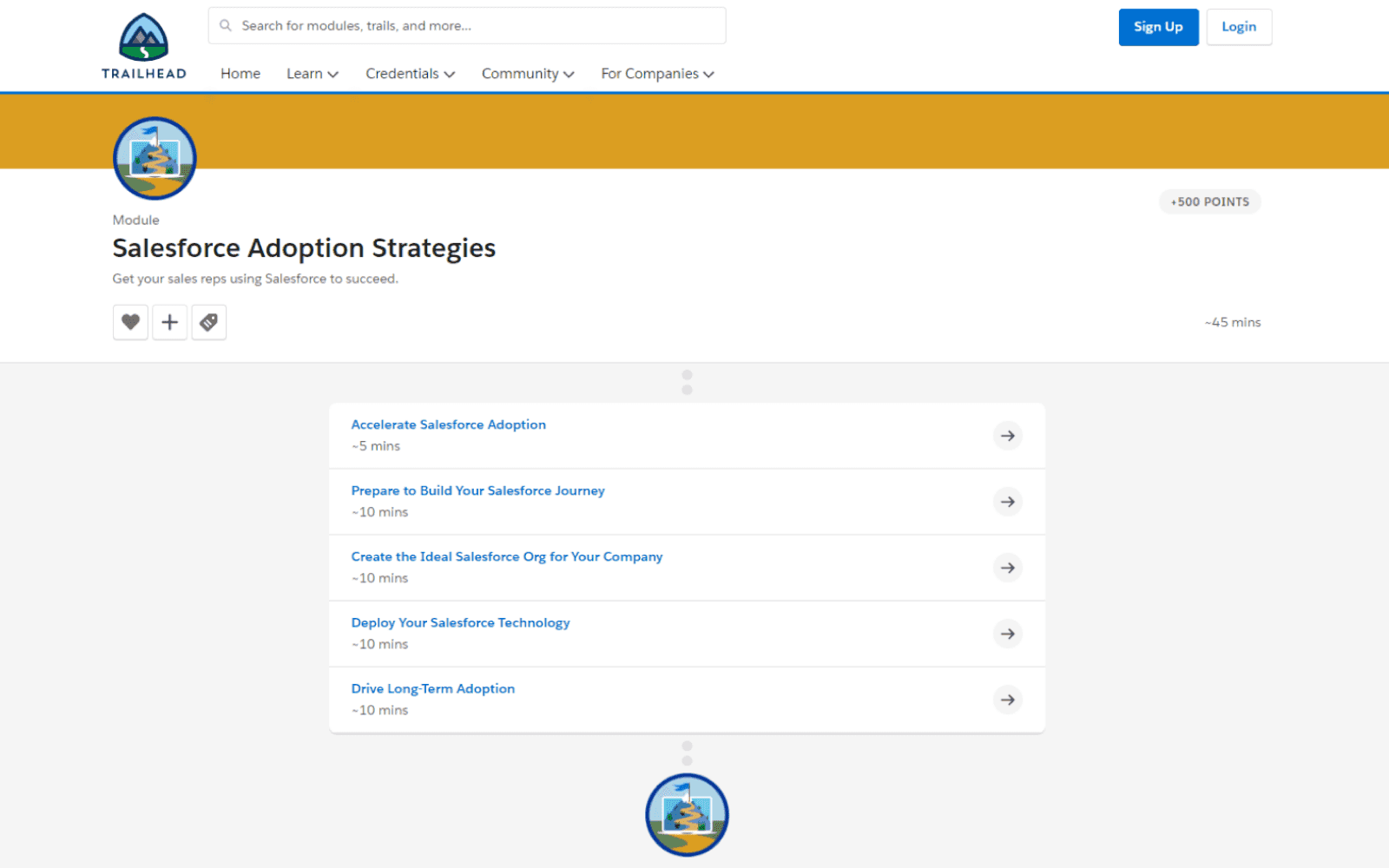
Salesforce adoption: best practices & challenges
March 5, 2024
- Home
- CRM services
- Salesforce services
- Salesforce adoption

by Anton Dubchak,
Salesforce Developer
Salesforce adoption is the process of incorporating this cloud-based CRM platform into a company's business operations through proper adoption, customization, and usage tracking initiatives.
Explore how our Salesforce experts help organizations with adopting Salesforce and overcoming common implementation challenges.
Salesforce adoption stats
Scheme title: Market shares of CRM platforms
Data source: International Data Corporation
~90%
of Fortune 500 companies use Salesforce to manage their business relationships
McKinsey
29.2%
of Salesforce CRM customers in 2022 were from the professional services industry
Statista
$1.6 tn
in new global business revenues created by Salesforce and its ecosystem of partners by 2026
International Data Corporation
Partner with Itransition to streamline Salesforce adoption
Phase 1: preparing for adoption
Set project goals & requirements
Start by documenting your processes and analyzing the existing tech ecosystem to identify pain points that Salesforce adoption should solve.
- Examine your processes stage by stage, searching for inefficiencies or specific tasks that can be fine-tuned and automated.
- Ask your staff about their experiences with the current CRM solution and related corporate software, focusing on challenges they’re facing and features they lack or find irrelevant.
- Conduct surveys, host focus groups, or monitor your sales team’s work to better define functional and nonfunctional requirements for your future solution.
Create an adoption plan
Based on the insights gathered in the discovery phase, set up a Salesforce adoption strategy detailing steps, timelines, and tasks.
- Create a plan covering key adoption stages, including customization and configuration, rollout, user training, feedback, and optimization. The entire project can span from six months to a year or two depending on the size of your organization.
- Establish and communicate employees’ roles and responsibilities in the adoption process, such as entering new contacts into Salesforce or mentoring other team members. This can include appointing adoption champions, or employees with previous experience in Salesforce.
- Define a change management strategy to identify and adjust any workflows potentially impacted by Salesforce adoption.
Communicate the value of Salesforce to end-users
Highlighting the benefits of Salesforce and demystifying the adoption process will encourage end-users to commit to the new customer relationship management solution.
- Explain to your employees why the organization needs a new system and how migrating to Salesforce should improve your business processes.
- Help users understand how Salesforce can benefit them specifically. For instance, they can save time using Einstein chatbots or avoid manual data entry after syncing Salesforce with their calendar and email tools.
- Communicate the Salesforce rollout timeline to future users and include feedback and support mechanisms enabling them to voice their concerns.
Phase 2: implementation
Tailor Salesforce to your needs
Using Salesforce’s extensive configuration options and customization opportunities, you can design a system tailored to your requirements.
- Configure the Salesforce interface to include the most frequently used tabs and actions. You can also customize the UI via Dynamic Forms, a feature available for Salesforce Lightning that lets you place fields and sections where needed.
- Implement role-based access to provide multiple users from different departments or managerial levels with custom interfaces featuring specific functions. For instance, if some users don’t need the Leads section as closing deals is not their task, their interface won’t see this tab.
- Enable access to useful customer data stored in third-party tools. If your employees use additional apps or services (be it Dropbox, DocuSign, or LinkedIn) for their work, consider integrating these apps with Salesforce to ensure an ongoing flow of information between them.
- Salesforce enables you to automate many routine tasks by creating rules and building flows. For example, you can sync data from emails, calls, and Jira with Salesforce, automate backups to external file storage, track orders and inventory, or use an AI chatbot to qualify leads. Salesforce Einstein AI further expands your automation possibilities.
- Personalize the user experience via Salesforce’s AppExchange app store, which offers thousands of useful add-ons covering specific business functions and industries.
Invest in user training
Salesforce’s steep learning curve calls for effective corporate training initiatives from new adopters.
- Provide new users with role-based Salesforce training covering specific functionality for marketing, sales, customer support, and analytics.
- If you aren’t sure where to start with these personalized learning pathways, check out Salesforce’s learning center, Trailhead. It offers learning trails for different roles, levels, Salesforce products, and functions.
- Complement Trailhead content with your own documentation and customize Salesforce’s Help Menu with links to your training materials. You can also implement In-App Guidance Prompts and Walkthroughs into user interfaces to offer tips via pop-up windows.
- If In-App Guidance is not enough, you can rely on a digital adoption platform (DAP), an automation system layered on top of your Salesforce solution that provides users with interactive walkthroughs and step-by-step overlays.
- Refer your employees to the Trailblazer Community, Salesforce’s self-help center where users discuss adoption issues and their solutions.

Image title: Salesforce Adoption Trail
Image source: trailhead.salesforce.com — Salesforce adoption strategies
Promote collaboration & team play
Building a collaborative environment is one of the cornerstones of an effective knowledge management strategy which can encourage employees to share their Salesforce expertise and speed up its adoption.
- Ask the most successful users to prepare shareable cheat sheets or make amateur how-to videos with their own tips and tricks for using Salesforce.
- Facilitate knowledge sharing with Chatter, Salesforce’s built-in social networking and collaboration tool that includes a chat system to communicate, send files, or gather feedback. You can also create Chatter Groups for individual teams or departments.
- Some companies choose gamification to drive Salesforce adoption via team play and competition. However, keep in mind that an over-gamified learning experience can divert employees’ attention.
Create incentives to use Salesforce
You should aim for a friendly and collaborative environment to encourage employees to use Salesforce and drive its adoption.
- Your management should lead by example. Indeed, executives referring to data stored outside Salesforce or team leads accepting reports created with different apps discourage your staff from using this system altogether.
- If your employees are used to certain apps that streamline their tasks (G Suite, Slack, Jira, etc.), integrate those apps with Salesforce. A synergistic ecosystem of tools will encourage them to use the new platform.
- The potential of Salesforce customization enables your organization to replicate almost any process familiar to your employees. So you need to highlight this possibility and encourage your staff to step forward and voice their customization requests.
Phase 3: post-deployment
Measure the results of Salesforce adoption
Measuring Salesforce usage across your organization and collecting user feedback will help you identify potential roadblocks and properly address them.
- Track Salesforce user adoption rates with metrics like logged users, created accounts, completed activities, neglected opportunities, or open tasks.
- User adoption dashboards offer a clear visual representation of such metrics. Salesforce admins can build custom dashboards with the platform’s built-in Reports and Dashboards features. Alternatively, you can leverage the free Salesforce Adoption Dashboards add-on available on AppExchange.
- Rely on Chatter Groups and online surveys to ask end-users for feedback on their experience with Salesforce, including bugs and other technical issues they’ve faced.

Image title: Salesforce Adoption Dashboards’ interface
Image source: appexchange.salesforce.com — Salesforce Adoption Dashboards
Audit Salesforce data
Entering accurate information into Salesforce results in higher-quality analytical insights and more comprehensive customer view, especially when you rely on a data-hungry tool like Einstein.
- Salesforce recommends keeping an eye on various data quality metrics, including accounts with all key fields populated, accounts missing rating fields, and prospect accounts missing.
- Regularly assess CRM data quality and data completeness with official or third-party tools. For instance, you can download the Data Quality Analysis Dashboards add-on for free from Salesforce AppExchange, along with partner products for address, email, and bank verification.
- Use Salesforce Optimizer’s data list section to monitor field usage and spot empty fields. Furthermore, some DAPs can identify data entered in the wrong format and alert users via field validation pop-ups and error messages.
Share positive results
Another way to retain your company's Salesforce users is to highlight the fruitful results the system is bringing.
- Share success stories of how employees boosted sales productivity and other KPIs or landed a high-profile client using Salesforce. Show how the overall performance of departments has improved since Salesforce’s launch.
- Praise employees who use Salesforce more frequently for their adoption efforts. For example, you can mention their achievements in Chatter.
- Highlight how data quality reports now contain fewer errors and inconsistencies. This way everyone who’s diligent in their Salesforce routine will feel their contribution is appreciated.
Our Salesforce services
Itransition is a certified Salesforce Partner that can guide organizations through their adoption journey and help overcome business challenges or technical issues.

- Assess your current Salesforce system
- Select a suitable Salesforce edition and feature set
- Define an implementation budget and roadmap
- Assist with configuration and customization
- Offer integration and migration advisory
- Provide user training and support
- Implement Salesforce into the target environment
- Set up your Salesforce system via customization or configuration
- Integrate Salesforce with your corporate systems
- Execute QA and user acceptance testing
- Migrate data from your legacy CRM to Salesforce
Implement your Salesforce solution with Itransition’s team
Common Salesforce adoption pain points
Issues
Recommendations
Lack of executive buy-in
Launching a Salesforce adoption project requires full support and commitment from decision-makers. However, executives can fear business process disruptions, budget overruns, or high long-term licensing costs, especially if the user base is expected to grow.
Launching a Salesforce adoption project requires full support and commitment from decision-makers. However, executives can fear business process disruptions, budget overruns, or high long-term licensing costs, especially if the user base is expected to grow.
Share successful case studies from other companies to highlight the benefits of adopting Salesforce. Different stakeholders can have specific expectations for Salesforce adoption. Gather their feedback and point out that your Salesforce adoption strategy will align with their vision.
Employee resistance to change
When your employees are used to certain routines and legacy tools, a new platform means stepping out of their comfort zone and acquiring new skills. This can lead to Salesforce’s inconsistent or limited usage.
When your employees are used to certain routines and legacy tools, a new platform means stepping out of their comfort zone and acquiring new skills. This can lead to Salesforce’s inconsistent or limited usage.
Communicate the benefits of Salesforce adoption, such as automating time-consuming clerical processes to reduce their workload. Implement a system of incentives to reward employees who consistently use the new tool.
Complex usage
According to dozens of G2 reviews, one of the most common barriers to Salesforce adoption is the platform’s complexity and steep learning curve. Furthermore, Salesforce’s default UI and features may not be suitable for your usage scenario.
According to dozens of G2 reviews, one of the most common barriers to Salesforce adoption is the platform’s complexity and steep learning curve. Furthermore, Salesforce’s default UI and features may not be suitable for your usage scenario.
Launch reskilling and upskilling initiatives, including collaborative training, to help employees familiarize themselves with Salesforce. Integrate personalized dashboards, automated workflows, and other elements to better meet end-user operational needs.
Poor data quality
Sporadic data entry, negligent record keeping, and information silos can result in incomplete, inaccurate, or inconsistent data. This can undermine Salesforce's role as a reliable customer information source and analytics tool.
Sporadic data entry, negligent record keeping, and information silos can result in incomplete, inaccurate, or inconsistent data. This can undermine Salesforce's role as a reliable customer information source and analytics tool.
Establish a data governance strategy providing guidelines for effective data management, including regular account data enrichment or archival and data quality audits. Enable seamless data exchange between Salesforce and other corporate systems or external services via native or third-party integrations to avoid inconsistencies.
User-centered Salesforce adoption
Despite its leading market position, Salesforce is not the easiest platform to introduce into your IT ecosystem. Its steep learning curve, combined with an overwhelming range of features, add-ons, and potential customizations, can intimidate future adopters and hinder the Salesforce implementation process. Companies should address such concerns by placing users at the center of their change management strategy and communicating the Salesforce vision to them, tailoring the solution to their operational needs, and offering reskilling initiatives and incentives. This user-oriented approach, along with Itransition’s expert guidance, can help you lay the foundation for successful Salesforce adoption.

Case study
Salesforce CRM implementation for a real estate company
Learn about Salesforce CRM implementation that helped a large real estate company increase their sales by 15% and shorten their sales cycle by 10%.

Service
CRM services and solutions
Hire CRM service providers with 10+ years of experience in CRM consulting, implementation, and development to get a 360-degree view of your customer data.

Case study
Salesforce development for a construction company
Find out how Itransition optimized a Salesforce-based system for a construction company and boosted the system usage by 30%.

Insights
AI in CRM: top use cases, best platforms, and guidelines
Explore the major use cases, real-life examples, and implementation best practices of AI in CRM, along with the top AI-powered platforms on the market.

Case study
Salesforce CRM for a US insurance buyout agency
Learn how Itransition’s customized Salesforce CRM has brought a US insurance buyout agency 54% more leads.